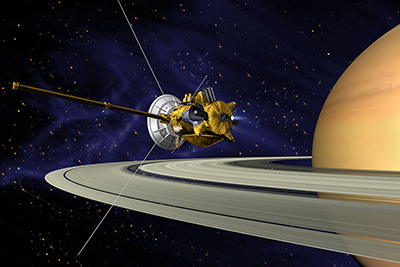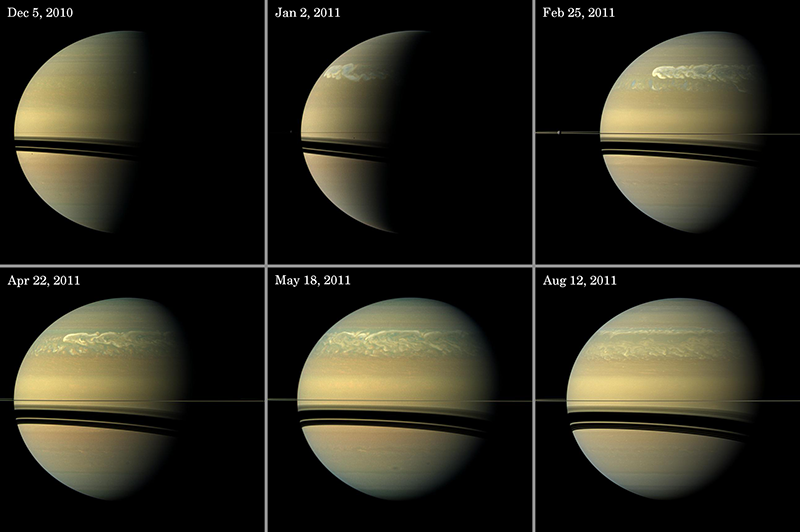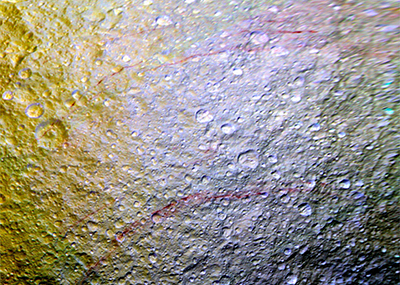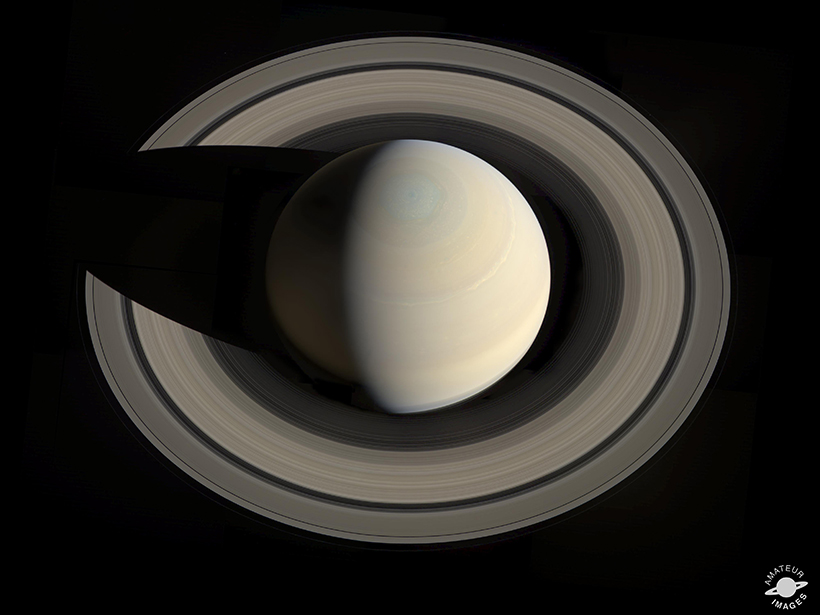As summer closes and children around the country gear up for a new school year, a mission that fundamentally changed how we think of life in the universe moves deep into its winter. On 15 September, NASA’s Cassini spacecraft will plunge into Saturn’s atmosphere and burn up, just weeks shy of its twentieth birthday.

The Cassini-Huygens mission launched on 15 October 1997, carrying 12 scientific instruments and a 2-meter-wide saucer-shaped probe called Huygens to land on Saturn’s hazy moon Titan. With it launched a generation of scientific careers and scientists who dedicated more than a decade of their lives to combing through gigabytes of data to understand the gas giant, its rings, and its moons. And those schoolchildren? They have never known a world without Cassini-Huygens.
The mission itself was conceived in the 1980s, after the Pioneer and Voyager spacecraft sent back images and data from the Saturn system that left scientists wanting more. Cassini’s primary goal was simple: explore Saturn and its surroundings and teach us about the strange places we saw and the data we received during previous spacecraft rendezvous.
Cassini-Huygens did not disappoint. Since its arrival at Saturn in 2004, Cassini has traveled more than 3 billion kilometers in more than 200 orbits around Saturn. It has flown by Titan more than 100 times and the icy ocean moon Enceladus 23 times. And on 14 January 2005, when the Huygens probe touched down on Titan, the mission became the first to successfully drop a lander on an outer solar system moon.
Over the course of its travels, Cassini-Huygens has transmitted more than 300,000 raw images of the planet, its moons, and its rings. Caught in Cassini’s web, our imaginations were—and still are—ensnared by Titan’s murky methane lakes; Saturn’s vast, roiling storms; and, perhaps most important of all, the potential for life below Enceladus’s sheath of ice.
Soon Cassini’s exploration of Saturn’s neighborhood will end and with that the steady stream of images, data, and scenes of curious landscapes.
But soon Cassini’s exploration of Saturn’s neighborhood will end and with that the steady stream of images, data, and scenes of curious landscapes. For Linda Spilker, the Cassini-Huygens mission’s head scientist, Cassini’s end feels like a high school graduation. After the mission ends, she said, the Cassini team will disperse “and go all different directions. We’re going to take our knowledge that we’ve learned from Cassini and use that to go forward into the future for the next mission,” whatever that may be.
There are feelings of sadness, of course, she continued, but also of “tremendous pride in all that Cassini has accomplished.”
And those accomplishments pile high. Here are 10 notable findings from data spanning the Cassini-Huygens mission.
1. Cassini Revealed Enceladus’s Potentially Habitable Internal Ocean

In July 2005, mission scientists sent Cassini flying by Enceladus’s south pole. Enceladus, its ice-covered south pole gouged with deep crevasses, orbits within Saturn’s magnetic field. But the magnetic field acts strangely around Enceladus—it responds to the moon somewhat akin to how magnetic fields act around bodies with thin atmospheres. So researchers sent Cassini to look for that atmosphere.
What they found changed almost the entire focus of the mission. During that flyby, instruments detected water vapor and ice grains. These data, along with data showing that the south pole is warmer than the rest of Enceladus, tipped them off that Enceladus is geologically active. Then, in November, images returned to Earth displayed bright plumes of water and ice spewing from south pole crevasses.
Scientists were stunned. Enceladus doesn’t have an atmosphere. It hosts jets of water spewing out its icy surface.
Intrigued, the team added 19 more Enceladus flybys; by mission’s end, Cassini had swung past the moon 23 times.
Through those flybys, scientists found that Enceladus’s ice shell encloses a global ocean. By sending the spacecraft through the fountains again and again, researchers detected sodium, water vapor, and organic molecules composed of oxygen, nitrogen, carbon, and hydrogen—molecules thought to be important for life. They even recently found molecular hydrogen in the plumes, which suggests that the ocean’s floor may host minerals reacting with hot water. Could these be hydrothermal vents, which on Earth teem with life?
“Cassini has shown that Enceladus satisfies almost all the present criteria that define habitability.”
“Cassini has shown that Enceladus satisfies almost all of the present criteria that define habitability,” said Hunter Waite, principal investigator on Cassini’s Ion and Neutral Mass Spectrometer and researcher at the Southwest Research Institute in San Antonio, Texas. Those criteria would be liquid water, organic molecules, and an energy source for microbes (the possible seafloor hydrothermal activity).
Unfortunately, Cassini does not hold instruments that can study the ocean’s depths, Spilker said. “Had we known that Enceladus had geysers, we would have maybe picked some instruments to help answer” the question of whether life exists underneath the icy shell.
“We must go back and look for life,” Waite added.
2. Huygens Showed Us Titan, a Possibly Primordial Earthlike World
When Voyager passed by the Saturn system, it sent back images of Saturn’s largest moon, Titan, covered in a thick, yellowy haze. Voyager’s infrared spectrometers detected a nitrogen-rich atmosphere peppered with hydrocarbons and organic molecules thought to be biological precursors, leading scientists to speculate that Titan could resemble a primordial Earth. To investigate further, the European Space Agency designed the Huygens probe, which hitched a ride to Titan on Cassini’s back.
On 24 December 2004, the saucer-shaped craft popped off Cassini and careened toward Titan. Several weeks later, on 14 January 2005, Huygens parachuted onto Titan’s surface. Throughout the 2.5-hour journey, Huygens gathered the first in situ data about Titan’s atmosphere and sent humanity the first pictures of the moon’s surface. Mission scientists took those images and stitched together this video:

Cassini has flown by Titan more than 100 times since 2005. Some flybys aimed to sample its upper atmosphere and observe surface features, whereas others allowed Cassini to gaze at Titan’s clouds and study its climate.
The flybys showed that Titan is more complex than anyone imagined, said Elizabeth Turtle, a planetary scientist who works with Cassini’s Imaging Science Subsystem and radar instruments. Cassini-Huygens revealed that Titan’s atmosphere holds heavy, carbon- and hydrogen-rich complex ions, thought to be precursors of life. Dunes of electrified hydrocarbon sand sweep over Titan’s surface, hinting at an atmosphere whipped by wind. Storm clouds dump methane rain that may carve river channels through the frozen surface. This rain may also help to fill the lakes of liquid methane and ethane that spread across the north pole. The liquid cycling of methane is akin to Earth’s water cycle, scientists speculate.
Could Titan be a window into our own planet’s past?
Although Huygens and Cassini revealed much about Titan, there are still mountains more mysteries to solve, Turtle noted. How do complex molecules form in the atmosphere? How do the lakes and seas get their liquid hydrocarbons, solely from the rain or possibly from a subsurface reservoir? Could Titan be a window into our own planet’s past?
3. Cassini Changed How We Think of “Habitability”
The Cassini-Huygens mission’s observations of Enceladus and Titan marked one of the mission’s most profound legacies: a tectonic shift in how we think of “habitability.”
Before Cassini-Huygens, when scientists pondered life beyond Earth, they imagined searching terrestrial planets like Mars or Venus, orbiting close enough to the Sun where liquid water could pool on a rocky surface. Unfortunately, Venus turned out to be a scorching hot planet with a runaway greenhouse gas effect, and a cavalcade of rovers has yet to find biological traces on Mars.
Ocean worlds encapsulated by ice are now targets in the broader search for life beyond Earth.
But Cassini-Huygens changed the game when it found complex hydrocarbons on Saturn’s ocean moons, hinted at hydrothermal vents on Enceladus, and revealed a cycle of liquid methane on Titan, explained Scott Edgington, the Cassini team’s deputy project scientist.
The bottom line is, ocean worlds encapsulated by ice are now targets in the broader search for life beyond Earth. “Those two tiny little moons in the Saturn system have changed our paradigm” of what a “habitable” world might look like, Edgington said.
4. Cassini Found Enceladus Ocean Material in the E Ring
Saturn’s outermost ring, the E ring, is huge, stretching from Titan to the smaller moon Mimas (a distance of about 1 million kilometers). The ring is also puffier than the other flatter rings encircling Saturn.

But that’s not the strangest thing about the E ring. Enceladus, that game-changing moon, orbits Saturn within this ring. In fact, Enceladus orbits in the densest part of this ring. Once the Cassini team discovered Enceladus’s geyserlike plumes in 2005, they wondered, Could particles from Enceladus’s plumes be bulking up the E ring?
Analyzing icy tendrils of particles jetting out of Enceladus and comparing those particles to E ring particles answered this question: Yes, some of the plume material does indeed leave the moon fast enough to populate the ring, rather than falling back onto Enceladus’s surface.
This finding is particularly exciting because it “makes the entire ring a sample of the moon’s interior,” said Matthew Hedman, a physicist at the University of Idaho in Moscow who studies Saturn’s rings. Perhaps by studying E ring particles, scientists can learn more about Enceladus’s interior ocean, he noted.
5. Cassini Unlocked Mysteries of Saturn’s Hexagon

“If you’re a meteorologist, you love Saturn,” said Edgington.
One of Saturn’s features that fascinates atmospheric enthusiasts is the six-sided north polar jet stream simply deemed “the Hexagon.” Voyager’s images hinted at the structure back in the 1980s, but Cassini confirmed its existence once and for all. The Hexagon spans 25,000 kilometers, and thermal imaging revealed that it may extend 100 kilometers down into the planet’s atmosphere.
The Hexagon is a polar jet stream of winds, similar to the river of winds whipping around Earth’s latitudes. The difference is that Earth’s jet stream dips and wiggles because of landmasses and oceans pulling it every which way, Edgington said.
In contrast, Saturn’s hexagon might be what an undisturbed polar jet stream looks like in an atmosphere devoid of land and oceans. Why the jet stream is six sided rather than five or eight sided is still a mystery.
6. Cassini Showed Us One of Saturn’s Huge, Infrequent Storms…
Small thunderstorms pop up from time to time on Saturn, but huge storms arise only about once every 30 years, Spilker said. Because Cassini has orbited the planet for such a long period of time, scientists got to witness one of these massive, global storms from beginning to end.
When Voyager flew by Saturn, it detected lightning, but researchers were unsure of where the lightning signature came from; some even thought it could be from the rings, said Robert West, a coinvestigator on Cassini’s Ultraviolet Imaging Spectrograph (UVIS) instrument. But Cassini’s instruments showed us storms “rising and setting over the horizon” as the planet turned, confirming that the lightning came from Saturn’s atmosphere, he continued.
Then, in 2010, a large white spot formed, signaling a storm. The storm stretched 10,000 kilometers across, about the size of Earth. The planet’s rotation dragged this storm along until it became a band streaking across the planet, widening north to south to span 15,000 kilometers.

Over the next several months, as Saturn rotated, the storm continued to drag around the planet like a ribbon, covering 5 billion square kilometers, until one day the tail of the storm collided with the head of the storm and “they annihilated each other,” West said. Then, over just a week, the storm’s activity ceased.
Scientists still aren’t sure why the storm abruptly ended, he noted.
7. …And That Storm Helped Cassini Detect Atmospheric Water
Studying this massive storm also showed that water exists in a lower layer of Saturn’s atmosphere.
On Earth, storms arise because of atmospheric convection from surface heating aided by water vapor that is slightly more buoyant than the rest of the atmosphere. Cool, dense air sinks, and hot, light air rises. The turbulence from this mixing can induce a thunderstorm.
But on Saturn, water is the heavier component. It condenses under hydrogen, helium, and clouds of ammonium sulfide and ammonia. This cap of dry upper layers over wet layers suppresses storm formation for a long time, researchers found.
Because of the lack of mixing between dry and wet layers, the dry region above the water layer eventually cools, becomes heavy, and sinks, pushing the wetter layer upward. This sets off a domino effect of convection like on Earth, but on a much larger scale. During the 2010 storm, that wet layer eventually “punched through the upper clouds” as the dry layer sank, and Cassini was able to clearly detect water clouds in the atmosphere, West said.
8. Cassini Dazzled Scientists with Saturn’s Color-Changing Atmosphere
When Cassini reached Saturn, its northern hemisphere was just coming out of a 7-Earth-year-long winter. Upon arrival, scientists found a crisp, blue atmosphere, West said, rather than the yellowy beige that researchers were used to from ground-based observations.
The blue was a hint of a “clean” atmosphere.
Scientists were quick to discover the reason: This blue was a hint of a “clean” atmosphere. Saturn’s upper atmospheric layers are formed mostly of hydrogen and helium, which scatter blue light, and methane, which absorbs red light, West said. So light that scatters off the atmosphere takes on a bluer hue.
Then, as summer peaked in Saturn’s northern hemisphere, Cassini observed a color shift to yellow. This happens because sunlight breaks apart methane, and those broken pieces form long chains of hydrocarbons that form particles. These particles, in turn, scatter light toward the red end of the spectrum. These chemical reactions, which are similar to the creation of smog on Earth, create Saturn’s yellowy haze.
What’s more, Saturn’s hexagonal polar jet stream often remains blue long after the surrounding atmosphere turns yellow: This is partly because it doesn’t receive as much sunlight as the lower latitudes, Edgington said, and partly because the sides of the jet stream block mixing from lower latitudes.
9. Cassini Spied Saturn’s Rings Acting Like a Seismometer

Scientists on Earth can figure out our planet’s internal structure by studying the way earthquake waves move through the ground. But Saturn is a gas giant, devoid of earthquakes. With Cassini, however, and its hundreds of images of Saturn, scientists noted something curious: waves propagating through Saturn’s rings.
Gravitational pull from the planet’s many ring-bound moons can create undulations, but calculations showed that these tugs alone were not enough to produce the signal observed by Cassini. Something else was going on.
By studying thousands of images and running thousands of calculations, scientists tracked the source of these mysterious waves to Saturn itself.
“It’s like the rings are giving you a window into the interior of the planet, much like earthquakes and the frequencies of the waves they generate give you a window into the structure of the Earth,” Carolyn Porco, the imaging team leader for the Cassini mission, told National Geographic.
But what these waves tell us about Saturn’s interior remains a mystery.
10. Cassini Showed Us Saturn’s Other Dynamic Moons

Enceladus and Titan may capture scientists’ imaginations when it comes to habitability, but Saturn’s other moons beckon with mysteries as well.
Tethys, for instance, which orbits in Saturn’s E ring, sports long, mysterious red streaks across its surface. “Nobody has seen anything like them anywhere else in the solar system,” said Amanda Hendrix, a coinvestigator on Cassini’s UVIS instrument and resident icy moon expert at the Planetary Science Institute in Tucson, Ariz.
Unfortunately, Cassini spotted the stripes too late in the mission to garner closer inspection—it’s not a trivial task to change the trajectory of the spacecraft for more flybys, Hendrix noted. The most mysterious aspect of the stripes is their apparent young age. Researchers can estimate the ages of planetary surface features by counting craters and the relative age of features by what’s covering or underneath a crater. But these stripes travel over craters and the surrounding surface, a signal of youth. Nothing seems to have weathered the stripes or hit them.

“It really is like someone took a crayon and drew on the surface yesterday,” Hendrix said.
Then there are Saturn’s “tutu” moons (or enchilada moons or walnut moons or ravioli moons, depending on whom you ask). The tiny moon Pan, which cleared out its own path through Saturn’s A ring, made a splash on social media when new high-resolution raw images were released by the mission team.
Even tiny Dione, half the size of our own Moon, could harbor an internal ocean, Hendrix said. Instruments on Cassini have detected a magnetic signal similar to the signal from Enceladus that hinted at its plumes. But subsequent flybys of Dione have uncovered nothing, Hendrix said.
“They all have their own personalities,” Hendrix joked.
Cassini’s Farewell
With oceans of data left to process and interpret, the Cassini-Huygens mission will influence research decades into the future. But it’s no easy task to say goodbye to a mission that to some, shaped their very careers. West likened the end of a mission to a divorce, whereas Hendrix went even further: “It really is almost a death,” she said. “Just thinking about it, how [Cassini is] going to be gone, it’s a little weird.”
Leigh Fletcher, an astronomer at the University of Leicester in the United Kingdom, started working on his Ph.D. studying Saturn’s and Titan’s atmospheres in 2004, about the time Cassini entered Saturn’s orbit. He still works with Cassini data to this day, studying Saturn’s atmosphere using Cassini’s Composite Infrared Spectrometer.
“Whenever I watch the [animated] movie of Cassini’s final demise, it’s hard not to feel moved,” Fletcher said, referring to a video NASA released in April that simulates Cassini’s upcoming crash with Saturn. Fletcher feels “pride in what we’ve accomplished, gratitude that I was offered a chance to become involved, and sadness that a team I’ve worked with for 13 years will now be moving on to pastures new.”
Sarah Hörst of Johns Hopkins University, who studies Titan’s atmosphere, says she’ll miss looking up to the sky every morning and saying, “Hello Saturn, hello Cassini!” on her way to work.
In the spacecraft’s last few seconds, before it disintegrates in Saturn’s atmosphere and the molecules that make up its instruments and structure become part of Saturn itself, “Cassini will be like a Saturn probe,” Spilker said, collecting its first—and last—direct measurements of the upper atmosphere.
And a billion kilometers away, past planets, moons, and asteroids, scientists will receive those data “until the very end,” she said.
—JoAnna Wendel (@JoAnnaScience), Staff Writer
Citation:
Wendel, J. (2017), Saturn unveiled: Ten notable findings from Cassini-Huygens, Eos, 98, https://doi.org/10.1029/2017EO077957. Published on 19 July 2017.
Text © 2017. The authors. CC BY-NC-ND 3.0
Except where otherwise noted, images are subject to copyright. Any reuse without express permission from the copyright owner is prohibited.

